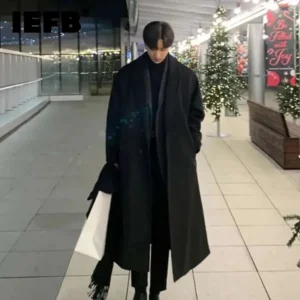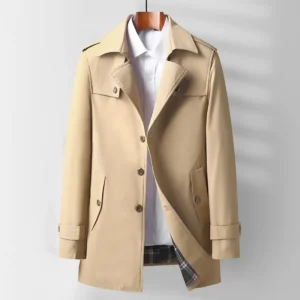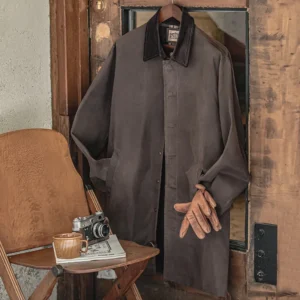What Defines a Men’s Dress Coat?
A men’s dress coat represents the pinnacle of outerwear formality, characterized by its refined structure, quality materials, and tailored silhouette. Unlike casual jackets that prioritize comfort and utility, dress coats emphasize sophistication and elegance through their design elements.
The key characteristics that define a proper dress coat include:
- Structured shoulders that create a clean, defined line
- Tailored fit through the chest and waist
- Premium materials like wool, cashmere, or high-quality blends
- Refined details such as hand-stitched buttonholes and quality linings
- Appropriate length that complements formal attire
Understanding the right coat length forms a crucial foundation for selecting appropriate dress coats. This knowledge becomes particularly important when distinguishing between similar outerwear pieces like parkas, bomber jackets, or casual raincoats that lack the refinement necessary for formal settings.
Dress coats exist along a formality spectrum, ranging from highly structured formal overcoats designed to complement tuxedos to slightly more relaxed sport coats that pair with smart casual attire. The selection of an appropriate dress coat depends largely on the formality of the event and the desired aesthetic impression.
For those seeking visual examples of proper dress coats, exploring a collection of men’s dress coats provides clarity on the distinguishing features that separate truly formal outerwear from casual alternatives.
Essential Types of Men’s Dress Coats
Understanding the distinct categories of men’s dress coats helps ensure appropriate selection for various events. Each type serves different functions and carries its own level of formality.
The Overcoat
The overcoat represents the most formal outerwear option, designed specifically to be worn over suits and formal attire.
- Typically extends to knee length or slightly below
- Constructed with heavyweight wool or cashmere for warmth
- Features structured shoulders and a tailored silhouette
- Often includes details like a chest pocket and flap pockets
- Classic colors include navy, charcoal, and black
The finest men’s overcoats feature quality construction details like hand-stitched lapels, fully canvassed fronts, and premium horn buttons that distinguish them from mass-produced alternatives.
The Topcoat
The topcoat serves as a slightly lighter alternative to the overcoat while maintaining formal appeal.
- Typically ends around mid-thigh
- Made from medium-weight wool or wool blends
- Clean, streamlined appearance with minimal detailing
- Versatile enough for business and formal evening events
- Often features a single-breasted front with three buttons
The Suit Jacket
While not technically outerwear, the suit jacket represents a cornerstone of formal dressing.
- Always matched with trousers of identical fabric
- Features structured shoulders and a defined waist
- Typically includes double vents for movement in formal settings
- Length covers the seat completely
- Most formal in solid navy or charcoal wool
The Blazer
The blazer offers slightly less formality than a suit jacket while maintaining polish.
- Often features distinctive metal buttons (traditionally brass)
- Usually crafted in navy blue with a slightly relaxed structure
- May include patch pockets instead of flap pockets
- Designed to pair with non-matching trousers
- Appropriate for business casual and smart casual events
The Sport Coat
The sport coat presents the most relaxed option while still qualifying as a dress coat.
- Features textured fabrics like tweed, herringbone, or hopsack
- Often includes details like elbow patches or ticket pockets
- More relaxed cut than blazers or suit jackets
- Originally designed for sporting activities (hence the name)
- Pairs well with casual trousers and jeans for smart casual settings
The Tuxedo Jacket
The tuxedo jacket represents specialized formal evening wear.
- Distinguished by satin or grosgrain lapels
- Traditionally single-button front closure
- No vents or side vents only (never center vents)
- Paired exclusively with matching formal trousers
- Reserved for black tie and formal evening events
Other borderline dress coats include well-tailored trench coats and structured peacoats, which can complement formal attire when properly styled and constructed from premium materials.
Matching Dress Codes: The Right Coat for Every Event
Navigating event dress codes requires understanding the appropriate coat selection for each formality level. Proper men’s coat length plays a crucial role in creating a balanced silhouette appropriate for specific occasions.
Black Tie
The most formal civilian dress code demands impeccable outerwear choices:
- Proper overcoat (preferably black or midnight navy wool)
- Full-length silhouette extending below the knee
- Clean, minimal detailing without excessive pockets or embellishments
- Worn open when arriving/departing to showcase the tuxedo underneath
- May include velvet collar for additional formality
Black Tie Optional
This slightly relaxed formal code allows:
- Classic overcoat in dark colors (navy, charcoal, black)
- Option for either tuxedo or dark formal suit underneath
- Traditional styling without experimental design elements
- Quality construction with clean lines and proper proportions
Cocktail/Semi-Formal
This versatile dress code permits:
- Topcoat or overcoat depending on weather and personal preference
- Darker colors still preferred but with some flexibility
- May incorporate subtle patterns like herringbone or pinstripes
- Can accompany a suit or blazer with formal trousers
Business Formal
For professional settings requiring traditional business attire:
- Classic overcoat or topcoat in conservative colors
- Length covering the suit jacket completely
- Traditional styling that projects authority and competence
- Subtle detailing that enhances rather than distracts from the overall look
Wool overcoats provide the perfect balance of warmth and sophistication for these professional environments, offering protection from the elements without sacrificing polish.
Business Casual
This increasingly common workplace dress code allows:
- Blazers and sport coats as primary outerwear
- Structured topcoats for colder weather
- More freedom with colors and patterns
- Relaxed styling details like patch pockets or unique buttons
Smart Casual
For polished yet relaxed settings:
- Sport coats in textured fabrics
- More expressive colors and patterns
- Contemporary styling elements like ticket pockets or unique linings
- Can be paired with dark jeans or casual trousers
Event-Specific Considerations
- Weddings: Match coat formality to the specified dress code and time of day
- Evening galas: Prioritize darker colors and formal silhouettes
- Seasonal parties: Adjust fabric weight and color appropriately
- Cultural events: Research any specific expectations or traditions
Misinterpreting dress codes often leads to discomfort and inappropriate attire. When in doubt, it’s better to arrive slightly overdressed with a classic coat choice than to appear underdressed with casual outerwear.
Mastering Fit: The Foundation of Style
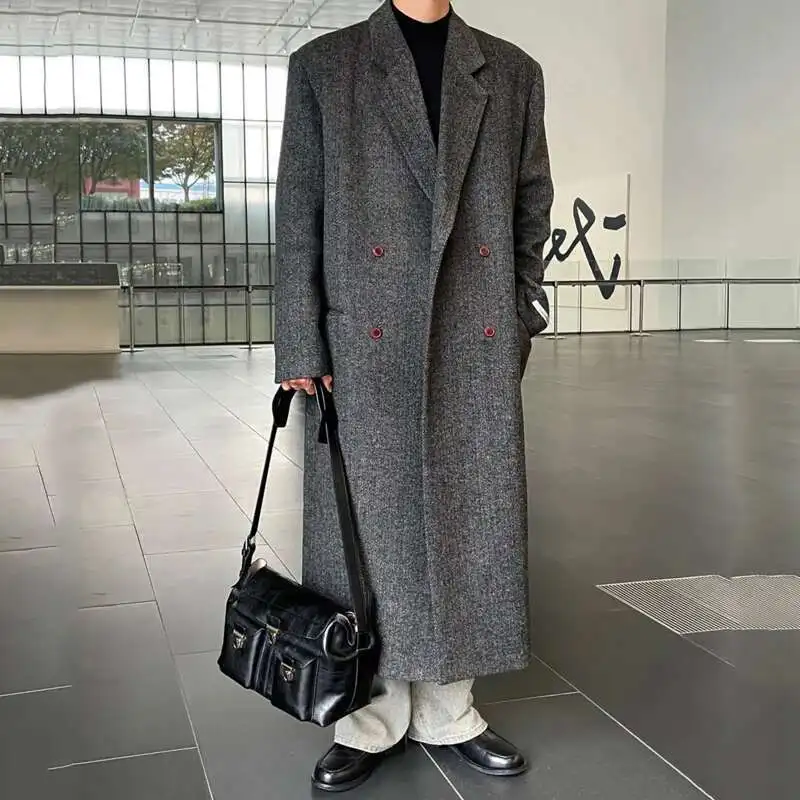
The difference between an ordinary coat and an exceptional one lies primarily in its fit. Even the most expensive garment fails to impress when poorly fitted, while a modestly priced coat can look remarkable when tailored to perfection.
Essential Fit Guidelines
Shoulders:
– The shoulder seam should align exactly with your natural shoulder edge
– No dimpling or pulling across upper back when arms hang naturally
– Shoulder padding should enhance your silhouette without creating an exaggerated line
Chest and Torso:
– Closed buttons should not create an “X” of tension
– Allow 2-4 inches of room beyond your actual chest measurement
– Additional space for layering over suits (approximately 1 inch)
– Clean drape without bunching at the sides
Length:
– Overcoats should fall between knee and mid-calf
– Topcoats typically end mid-thigh
– All dress coats should completely cover suit jackets or blazers
– Consider your height when determining ideal length
Sleeves:
– Should end at the base of your thumb when arms hang relaxed
– Allow approximately ½ inch of shirt cuff to show when wearing a suit
– No excessive break or bunching at the wrist
For those exploring more structured styles, learning how to style double-breasted coats provides valuable insight into this particularly demanding fit challenge. Double-breasted styles require especially precise tailoring to maintain their elegant lines.
Common Fit Issues and Solutions
- Shoulders too wide: Requires major reconstruction; better to select a different size
- Sleeve length: Easily adjusted by a tailor (up to 1 inch shorter or 2 inches longer)
- Body fullness: Can be taken in at side seams and back seam
- Collar gap: Indicates poor chest fit or shoulder alignment issues
When purchasing a dress coat, prioritize shoulder fit and overall length, as these alterations are difficult and expensive. Elements like sleeve length and waist suppression can be more easily tailored to achieve the perfect fit.
The Art of Pairing: Creating Complete Outfits
Mastering coat coordination requires understanding how each element contributes to a cohesive look. The key lies in balancing formality levels across all garments and accessories.
Shirt Pairings
- Formal overcoats: White or light blue dress shirts with French cuffs
- Topcoats: Crisp dress shirts in subtle patterns or solids
- Blazers: Oxford button-downs or dress shirts with spread collars
- Sport coats: Button-downs in patterns or textured fabrics
Trouser Coordination
- Suit jackets: Always paired with matching trousers
- Formal overcoats: Cover suit trousers or formal wool dress pants
- Blazers: Gray flannel, navy, or khaki dress trousers
- Sport coats: Can work with dark denim, corduroy, or casual wool trousers
Selecting the perfect coat length for your height creates visual harmony between your upper and lower body, ensuring balanced proportions throughout your outfit.
Neckwear Selection
- Formal settings: Silk ties in solids or subtle patterns
- Business settings: Repp stripes, small patterns, or solid ties
- Smart casual: Knit ties, textured options, or open collar
- Black tie: Bow tie exclusively (never regular necktie)
Footwear Coordination
- Formal overcoats: Black oxford dress shoes
- Business attire: Cap-toe oxfords, quarter-brogues
- Smart business casual: Loafers, derby shoes, full brogues
- Casual settings: Chelsea boots, chukkas, or refined leather sneakers
Essential Accessories
- Pocket squares that complement but don’t exactly match ties
- Leather gloves in brown or black depending on coat color
- Scarves in complementary colors or subtle patterns
- Minimal, quality watches that suit the formality level
For formal occasions, double-breasted overcoats create a particularly distinguished silhouette that pairs exceptionally well with tailored suits and formal accessories.
The most successful outfit combinations maintain consistency in formality, color palette, and overall aesthetic while allowing for thoughtful contrast in texture and pattern.
Seasonal Fabric Selection and Color Coordination
Strategic fabric selection ensures comfort and appropriateness across seasons while maintaining style integrity.
Winter Fabrics
- Heavy wool (20-30 oz): Maximum warmth for formal overcoats
- Cashmere: Luxurious insulation with refined appearance
- Wool-cashmere blends: Practical luxury with enhanced durability
- Tweed: Textured option for smart casual winter wear
Spring/Fall Fabrics
- Medium-weight wool (14-18 oz): Versatile option for transitional weather
- Gabardine: Tightly woven fabric with water-resistant properties
- Cotton-wool blends: Breathable with structure for mild temperatures
- Lightweight tweed: Less bulky option for textural interest
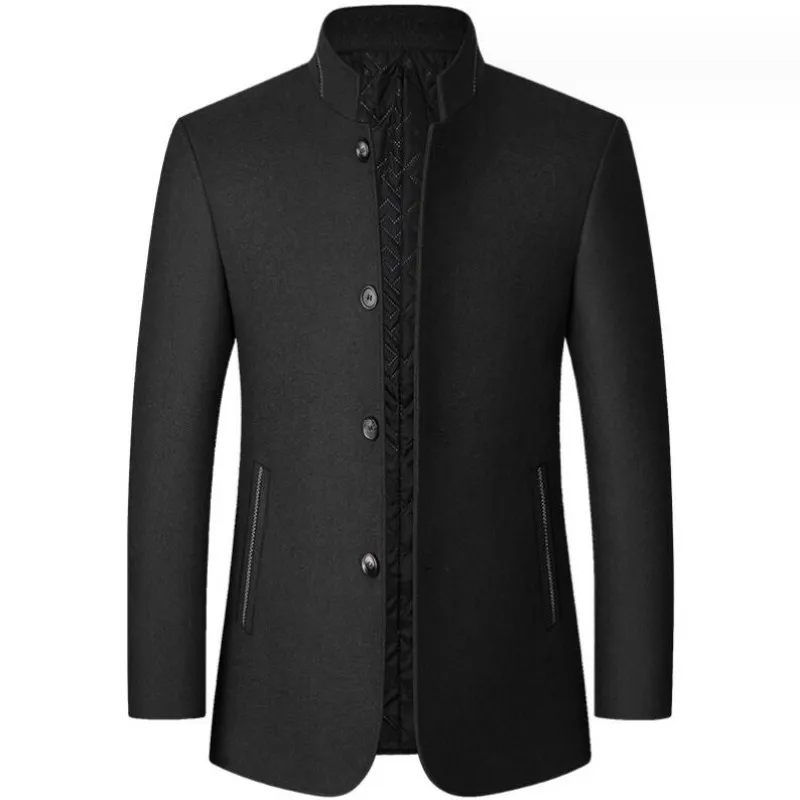
Summer Fabrics
- Tropical wool (7-9 oz): Breathable formal option for warm weather
- Cotton-linen blends: Lightweight with reduced wrinkling
- High-twist wool: Crisp appearance with natural temperature regulation
- Fresco wool: Open weave for maximum air circulation
Core Color Palette
- Navy: Ultimate versatility across all formality levels
- Charcoal gray: Sophisticated option that pairs with everything
- Camel: Classic statement color with timeless appeal
- Black: Essential for formal evening events
For adding distinctive texture to seasonal wardrobes, tweed coats provide character while maintaining appropriate formality for business and smart casual settings.
Pattern Guidelines
- Formal settings: Solid colors or subtle herringbone patterns
- Business environments: Small patterns like nail-head or fine check
- Casual contexts: Bolder checks, plaids, or distinctive textures
- Always scale pattern size appropriately to your frame
The most successful seasonal transitions involve thoughtful layering and fabric weight selection rather than dramatic style changes.
Expert Layering Techniques for Comfort and Style
Mastering layering allows for seamless transitions between environments while maintaining a polished appearance.
Key Layering Principles
- Choose progressively lighter fabrics as you move inward (heaviest layer on outside)
- Allow approximately one inch of additional room in dress coats to accommodate layers
- Maintain clean lines by avoiding bulky middle layers
- Create visual interest through subtle texture and color contrasts between layers
Practical Combinations
- Formal: Overcoat + suit jacket + dress shirt + optional fine gauge sweater vest
- Business: Topcoat + blazer + dress shirt + light merino sweater
- Smart casual: Sport coat + lightweight quarter-zip + button-down shirt
Understanding the art of layering under cashmere helps preserve the luxurious drape of fine outerwear while ensuring proper insulation.
Managing Multiple Layers
- Coordinate collar styles to prevent awkward bunching or visibility issues
- Match sleeve lengths proportionally across all garments
- Select appropriate coat length to cover all under-layers completely
- Choose compatible colors that work together when layers are partially visible
When properly executed, layering adds sophistication, visual depth, and practical versatility to dress coat ensembles while maintaining a streamlined appearance.
Wardrobe in Action: Event-Specific Outfit Examples
Translating principles into practice, these complete outfit examples demonstrate appropriate dress coat styling for specific occasions.
Winter Formal Event (Gala or Evening Wedding)
- Black wool overcoat with satin-faced lapels
- Black tuxedo with grosgrain lapels
- White piqué front dress shirt
- Black silk bow tie and matching cummerbund
- White linen pocket square (presidential fold)
- Black patent leather oxford shoes
- Black leather dress gloves
- Silver or gold cufflinks and dress studs
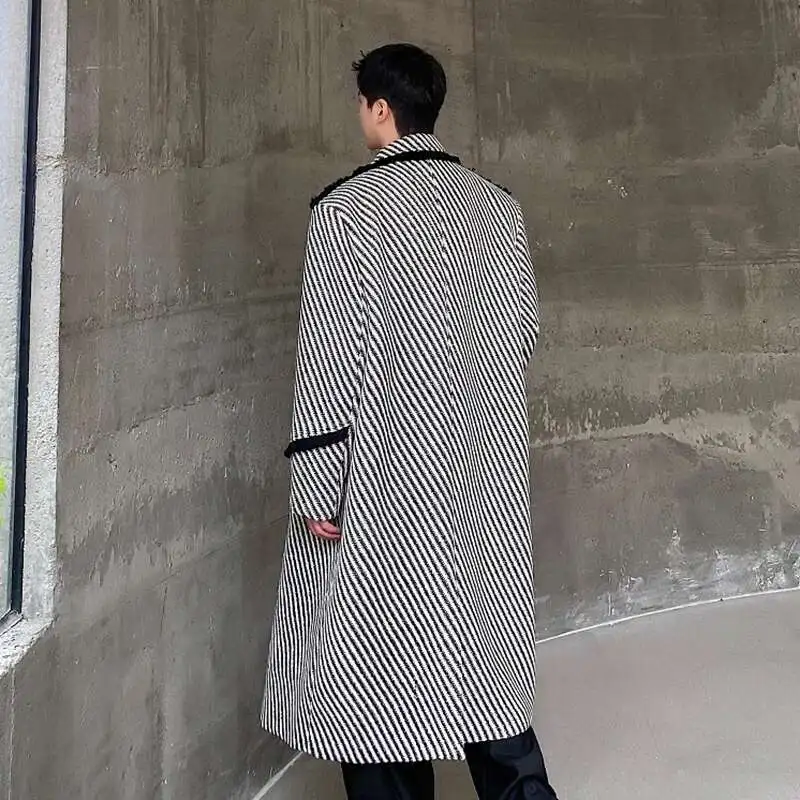
Business Meeting (Cold Weather)
- Navy topcoat in fine wool
- Charcoal gray or navy wool suit
- Light blue dress shirt
- Burgundy silk tie with subtle pattern
- White pocket square (TV fold)
- Black cap-toe oxford shoes
- Burgundy leather gloves
- Silver tie bar (optional)
Evening Cocktail Party (Fall/Winter)
- Camel topcoat or navy overcoat
- Navy blazer or dark gray sport coat
- White or light blue dress shirt
- Patterned silk tie or open collar
- Patterned pocket square with complementary colors
- Dark brown leather dress shoes (loafers or derbies)
- Neutral or burgundy dress socks
- Brown leather gloves
Smart Casual Gathering (Spring)
- Tweed sport coat in brown or olive tones
- Light blue or white button-down oxford shirt
- Navy, tan, or gray dress trousers
- No tie with open collar or knit tie
- Patterned pocket square
- Brown suede chukkas or leather loafers
- Tan or matching belt
Understanding the essential guide to men’s dress coats for business helps professionals navigate corporate dress codes with confidence and style.
Mens Cashmere Overcoat, Mens Hooded Winter Coat, Mens Wool Blend Coat
Price range: $128.72 through $139.68 Select options This product has multiple variants. The options may be chosen on the product pageMens Black Overcoat, Mens Black Wool Coat, Mens Wool Overcoat
$339.18 Select options This product has multiple variants. The options may be chosen on the product pageMens Grey Overcoat, Mens Wool Blend Coat, Mens Wool Overcoat
$201.28 Select options This product has multiple variants. The options may be chosen on the product pageMens Herringbone Coat, Mens Long Overcoat, Mens Wool Overcoat
Price range: $197.16 through $203.69 Select options This product has multiple variants. The options may be chosen on the product pageMens Long Overcoat, Mens Topcoats
Price range: $189.40 through $196.88 Select options This product has multiple variants. The options may be chosen on the product pageMens Long Overcoat, Mens Tweed Coat
Price range: $397.49 through $409.96 Select options This product has multiple variants. The options may be chosen on the product page
Common Styling Mistakes and How to Avoid Them
Even quality dress coats can fail to impress when common styling errors undermine their potential. Avoiding these pitfalls ensures your formal outerwear makes the right impression.
Fit Failures
Oversized shoulders: Creates a sloppy, borrowed appearance
Solution: Ensure shoulder seams align with your natural shoulder edgeExcessive length: Drowns smaller frames and appears dated
Solution: Choose length proportionate to your heightImproper buttoning: Leaving all buttons fastened on vented coats
Solution: Leave bottom button unfastened on single-breasted styles
Formality Mismatches
Too casual for the event: Wearing a sport coat to black tie
Solution: Research dress codes thoroughly before selecting outerwearOver-formality: Wearing a tuxedo-style coat to business casual events
Solution: Develop understanding of formality spectrum
Accessory Errors
Overaccessorizing: Combining too many statement pieces
Solution: Follow the “remove one item” rule before leaving homePoor color coordination: Clashing metals, leathers, or palette
Solution: Establish a core color scheme with complementary tones
Maintenance Issues
Visible wear: Frayed cuffs, shiny elbows, or damaged buttons
Solution: Regular inspection and timely repairsStorage damage: Hanger dimples, moth holes, or creases
Solution: Proper hanging and seasonal storage protocols
Addressing these common issues transforms average dressing into distinguished style while honoring the craftsmanship of quality outerwear.
Care and Maintenance: Preserving Your Investment
Quality dress coats represent significant investments that can deliver decades of service when properly maintained. Implementing these care practices extends garment life significantly.
Proper Hanging Techniques
- Use broad, contoured wooden hangers that support shoulders
- Allow space between hanging garments for air circulation
- Brush coat with natural bristle brush after each wearing
- Allow 24 hours rest between wearings when possible
Cleaning Guidelines
- Wool overcoats: Dry clean only, maximum twice per season
- Cashmere blends: Professional cleaning with specialized cashmere service
- Cotton/linen blends: Follow label instructions, typically dry clean
- Spot clean small stains immediately with appropriate products
Seasonal Storage
- Clean thoroughly before extended storage
- Use breathable garment bags (never plastic)
- Place cedar blocks or lavender sachets to deter moths
- Store in cool, dry location away from direct sunlight
Professional Maintenance
- Establish relationship with skilled tailor for minor repairs
- Address loose buttons and small tears immediately
- Consider reweaving for small holes in valuable pieces
- Schedule professional pressing rather than home ironing
With proper care, premium dress coats become true heritage pieces that improve with age and develop character through thoughtful wear and maintenance.
Developing Personal Style: Beyond the Basics
While understanding dress coat fundamentals creates a strong foundation, developing personal style allows for authentic self-expression within formal boundaries.
Thoughtful Personalization
- Experiment with subtle texture combinations rather than bold patterns
- Consider distinctive buttons on blazers and sport coats
- Explore lesser-known neutrals like olive, burgundy, or deep brown
- Incorporate personal heritage through subtle pattern choices
Proportion Consideration
- Adapt classic guidelines to complement your specific body type
- Experiment with lapel width that balances your shoulder breadth
- Adjust coat length within acceptable range to flatter your height
- Consider how different silhouettes enhance your natural build
Style Evolution
- Start with foundational pieces in classic colors and styles
- Gradually introduce distinctive elements as confidence grows
- Observe how respected style figures interpret formal boundaries
- Develop signature combinations that feel authentically personal
Metro Cloak’s design philosophy embraces this balance between timeless principles and individual expression, creating outerwear that honors traditional craftsmanship while accommodating contemporary lifestyles.
FAQ: Dress Coat Etiquette and Considerations
When should I remove my overcoat at formal events?
Remove your overcoat immediately upon entering indoor venues, preferably in the designated coat check area. For formal dinners, never wear your overcoat to the table.
How should I manage my coat during seated formal dinners?
Check your coat when possible. If no check service exists, fold it neatly with the lining inside and place it over the back of your chair, or drape it properly if separate seating exists for coats.
Is it appropriate to wear an overcoat unbuttoned?
Yes, overcoats may be worn unbuttoned when walking short distances or when briefly outdoors. For longer outdoor periods in cold weather, buttoning provides proper insulation and maintains the coat’s intended silhouette.
How can I quickly assess if my coat matches an event’s formality?
Consider the event time (evening events require more formal coats), venue formality, and specified dress code. When uncertain, a classic navy or charcoal wool topcoat represents a versatile choice for most formal occasions.
Should dress coats be tailored like suits?
Yes, proper tailoring enhances dress coat appearance significantly. While not requiring the precise fit of suits, attention to shoulder alignment, sleeve length, and overall drape dramatically improves the garment’s presentation and comfort.





